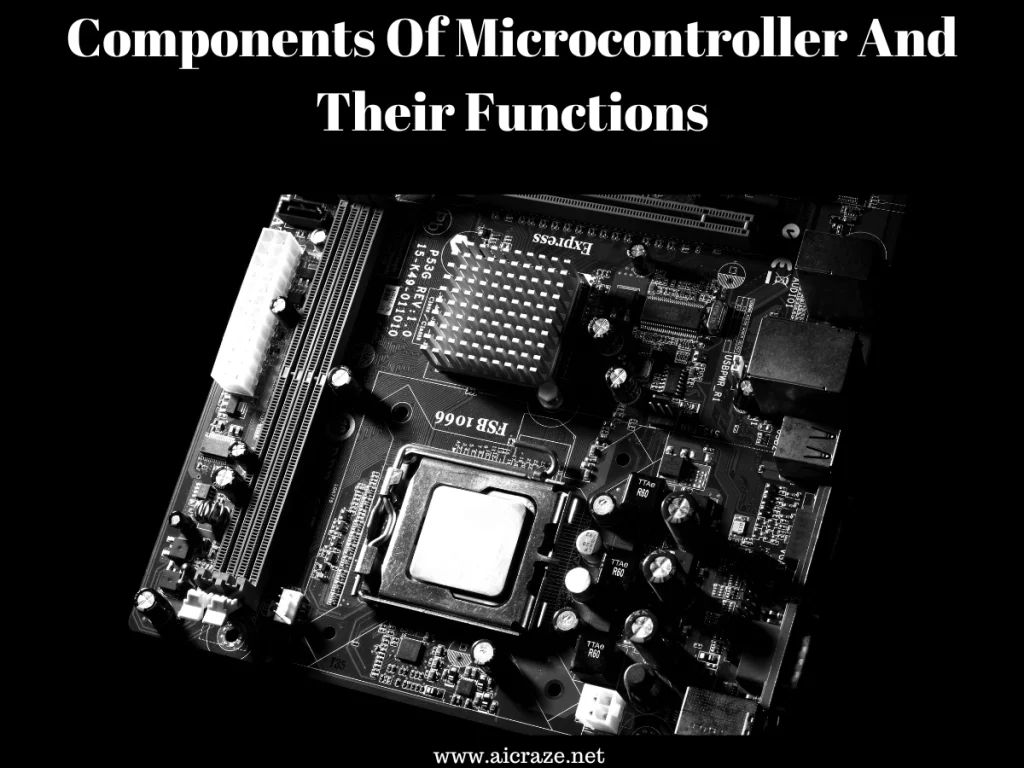
Microcontrollers are small computer-like devices that are used in various electronic devices to perform specific tasks. They are designed to control the operation of the device by interacting with other hardware components. There are various essential components of microcontroller that make it capable of performing the desired function. In this article, we will discuss the key components of microcontroller and their functions.
Processor Core
The processor core, also called the Central Processing Unit (CPU), is the main when talking about the components of microcontroller. It is responsible for processing and executing instructions received from the input devices. The processor core consists of the Arithmetic Logic Unit (ALU) and registers such as the stack pointer, accumulator register, program counter, as well as register file, among others. The ALU is responsible for performing arithmetic and logical operations, while the registers store temporary data for processing.
Memory
Memory is one of the crucial components of microcontroller, which enables them to store and retrieve information. Microcontrollers are manufactured with three types of memory: Random Access Memory (RAM), Read Only Memory (ROM), and Electrically Erasable Programmable Read-Only Memory (EEPROM). All these types of memory have unique characteristics and functions that participate in the overall performance of the microcontroller.
- Read-Only Memory (ROM)
ROM is non-volatile memory programmed with the manufacturer’s firmware or software. The program stored in ROM is permanent and cannot be changed. It performs to perform essential functions such as system initialization, input/output handling, and interrupt handling. ROM is also used to store lookup tables as well as calibration data which are needed by the microcontroller during operation.
- Random-Access Memory (RAM)
RAM is a type of volatile memory. The power shutdown causes the data stored in RAM to be lost. RAM serves as a workspace for the processor to perform calculations and for temporary data storage. It is faster than non-volatile memory and permits quick writing and reading. The microcontroller’s RAM size determines the amount of data that can be stored and manipulated simultaneously, and it is critical to select a microcontroller with enough RAM for the intended application.
- Electrically Erasable Programmable Read-Only Memory (EEPROM)
EEPROM is basically a type of non-volatile memory. It can be electrically erased as well as reprogrammed. It is used for storing data that requires to be retained even when the power is shut down, such as calibration data, user settings, and non-volatile program memory. EEPROM is slower than RAM and ROM but offers the advantage of being reprogrammable, making it ideal for applications. Where the data needs to be updated frequently.
Input/Output (I/O) Ports
Microcontrollers are highly versatile devices that are designed to integrate several hardware components on a single chip. These components of microcontroller enable it to perform complex functions with minimal external circuitry. One of the key components of microcontroller is the Input/Output (I/O) Ports. These ports enable the microcontroller to interface with the external world, receive input signals, and generate output signals.
Input/Output (I/O) Ports are electronic circuits designed to communicate with the outside world through sensors, switches, and other external devices. They allow the microcontroller to read the state of a switch or a sensor and generate an output signal that can control other external devices. In most microcontrollers, the I/O Ports are organized into groups. Each group has a specific function, such as data input, data output, or control input.
The I/O Ports of a microcontroller can be further classified into two types: parallel and serial. The parallel ports can transmit and receive data in parallel, meaning that they can transmit or receive multiple bits of data simultaneously. Serial ports, on the other hand, can transmit or receive data in a serial manner. It means that they transmit or receive one bit of data at a time.
One of the essential functions of I/O Ports is to provide a source of communication between the microcontroller and the external world. This communication can take many forms, such as sending and receiving data, controlling the state of an external device, or monitoring the state of a sensor. For instance, the microcontroller can receive signals from sensors, such as temperature sensors or pressure sensors, through the I/O Ports. The microcontroller can then use this data to make decisions or control external devices, such as motors or pumps.
Another crucial function of I/O Ports is to provide a means of interfacing the microcontroller with other digital devices. They achieve this by using protocols like SPI (Serial Peripheral Interface), I2C (Inter-Integrated Circuit), or UART (Universal Asynchronous Receiver-Transmitter) to establish communication between the microcontroller and the external device. In this way, the I/O Ports enable the microcontroller to communicate with other devices in a standardized and efficient manner.
Serial Bus Interface
A Serial Bus Interface (SBI) is one of the essential components of microcontroller. It is a communication interface that allows the microcontroller to exchange data with other devices in a serial manner. The SBI can communicate with different types of devices such as sensors, memory, actuators, and other microcontrollers.
The SBI functions as a master or a slave device. As a master device, the microcontroller controls the communication process by generating a clock signal and initiating the data transfer. As a slave device, the microcontroller responds to the commands and data transmitted by the master device.
One of the primary benefits of using an SBI is that it requires fewer wires for communication. The limited number of wires required makes it suitable for applications like embedded systems or IoT devices. Various manufacturers widely adopt the SBI protocol, making it simple to integrate different devices into a system.
Microcontrollers use different types of SBI protocols, such as I2C (Inter-Integrated Circuit) and SPI (Serial Peripheral Interface). The I2C protocol is commonly employed for short-distance communication between devices, while the SPI protocol is used for high-speed communication between devices.
The SBI also plays a crucial role in interfacing with external memory devices. In some microcontrollers, the SBI interface can be used to connect to external memory, such as EEPROM or Flash memory. This allows the microcontroller to expand its memory capabilities and store more data.

